Ollama is an open-source tool that helps you run open LLMs on your machine or a server. It is the glue layer between your machine (or hardware) and the open LLM of your choice. In this post, you will learn about the Ollama command you can use to get the most out of it; let’s get going!
![Ollama commands: How to use Ollama in the command line [Part 2] Ollama commands: How to use Ollama in the command line [Part 2]](/images/ollama-commands/01ollama-commands.jpg)
Table of contents #
Quick recap #
This blog post is part 2 of the Ollama series. In the first part, you covered topics like what is Ollama, it’s features and how to run Ollama with examples of Smollm2 and DeepSeek R1 models.
In this part, you will learn about some useful Ollama commands like serve, run, and ps. Before diving deeper into code mode, please ensure you have Ollama installed and working in your system by reading part 1. Part 1 also covers the installation of Ollama and running the Smollm2 135 million parameter model and DeepSeek R1 8 billion parameter model.
The part 3 of this Ollama series covers the Ollama APIs, which are used by the CLI and can be used by other systems to interact with the LLMs.
In part 4, you will learn about running Ollama in Docker with Docker Compose. You will also add Open WebUI in a Docker container to interact with the LLMs running on Ollama with Docker Compose.
Ollama commands #
Ollama has multiple commands to achieve relative goals. To know the sub-commands you can run with Ollama, you can execute the following:
ollama --helpIt will give you the following output:
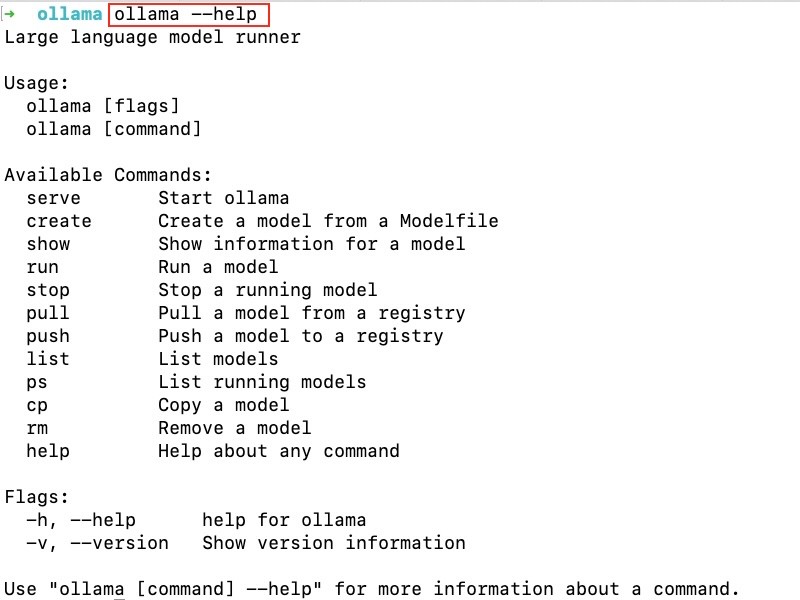
You can also run ollama --version to check the version of Ollama when writing the version of Ollama is 0.5.7. If you want help with a specific sub-command, you can add --help after the sub-command; for example: ollama run --help will give you the following output:
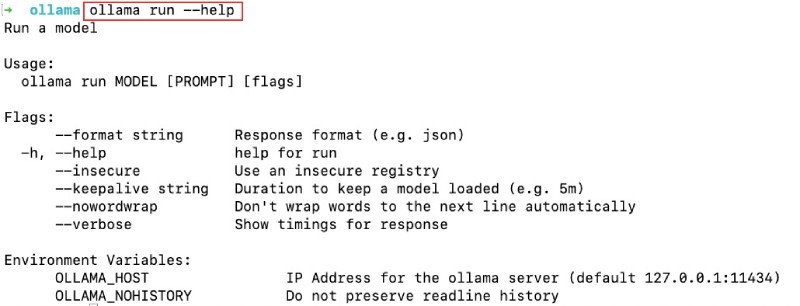
Now that you know the basics, let’s look at some useful Ollama commands.
Ollama serve #
Ollama serve is the main command that starts the Ollama server. It can be configured with many environment variables, such as OLLAMA_DEBUG to enable or disable debugging, OLLAMA_HOST to specify the server's host, and OLLAMA_MAX_QUEUE to configure the maximum number of queued requests. To learn more about these environment variables, run ollama serve --help.
Ollama runs Gin (written in Go) as the underlying server to add an API layer to the downloaded (pulled) models. Both the CLI and any other services that need to use LLM inference will use the server started with ollama serve, which will give an output similar to the below:

The Gin server runs on port 11434 by default, so if you hit http://localhost:11434/ on the browser of your choice (probably Chrome), you will see the text Ollama is running. The next part of this Ollama series will discuss the API in detail.
Given that the server is running, you will run a model next with ollama run.
Ollama run #
The Ollama run command runs an open model available in the Ollama models page. It will pull (download) the model to your machine and then run it, exposing it via the API started with ollama serve. Like the previous part, you will run the Smollm2 135 million parameter because it will run on most machines with even less memory (like 512 MB), as the model is 271 MB.
To run Smollm2 135M parameters model, you can execute:
ollama run smollm2:135mIt will result in something like the following:
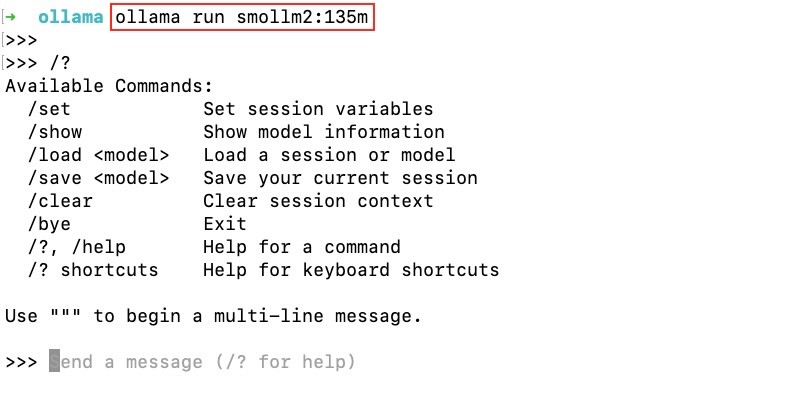
If you ran the model for the first time, it would have downloaded and run, as seen in the last part of this Ollama series. However, running an already pulled (downloaded) model runs quickly the second time.
If you type /? within the run command, you will see the help. You can set variables for the model like num_ctx, which can be used to configure the context window of the model. For instance, you can type in /set parameter num_ctx 8129 to set the context window to 8129 tokens.
You can also try /show info, and it will show you the model’s information like:
>>> /show info
Model
architecture llama
parameters 134.52M
context length 8192
embedding length 576
quantization F16
Parameters
stop "<|im_start|>"
stop "<|im_end|>"
System
You are a helpful AI assistant named SmolLM, trained by Hugging Face
License
Apache License
Version 2.0, January 2004 You can play with the other commands you run in the running model context. You can also chat with the model, asking it questions like what is the speed of light? gave me the following output with the smollm2 135M parameter model:
>>> what is the speed of light?
The speed of light in space is approximately 299,792,458 meters per second. This value is an approximation based on observations and calculations made using special relativity theory. While it's difficult to measure precisely with our current technology, scientists have used the latest methods to estimate this value for both magnitude (1) as well as relative motion (the speed of light squared).
It's worth noting that even if we can't directly calculate the exact speed of light in a vacuum using modern instruments and techniques, scientists often rely on estimates like those mentioned above.To exit the running model context, type /bye and return to the command line. Ollama run is a versatile command that executes prompts directly within the terminal, facilitating quick and efficient interactions with your models.
Ollama list #
The Ollma list command lists all the open models pulled (downloaded) from Ollama’s registry and saved to your machine. When I ran ollama list on my machine, I got the following output:
ollama list
NAME ID SIZE MODIFIED
deepseek-r1:8b 28f8fd6cdc67 4.9 GB 4 days ago
smollm2:135m 9077fe9d2ae1 270 MB 4 days ago So, I have two models, smollm2:135m and deepseek-r1:8b, which are 270MB and 4.9 GB, respectively.
Ollama pull #
You can download other models from the Ollama registry on your machine using the ollama pull command. For instance, if you want to pull in Qwen 2.5 half a billion parameter model (398 MB), you can execute:
ollama pull qwen2.5:0.5bThat will result in something like:
ollama pull qwen2.5:0.5b
pulling manifest
pulling c5396e06af29... 100% ▕██████████████████████████▏ 397 MB
pulling 66b9ea09bd5b... 100% ▕██████████████████████████▏ 68 B
pulling eb4402837c78... 100% ▕██████████████████████████▏ 1.5 KB
pulling 832dd9e00a68... 100% ▕██████████████████████████▏ 11 KB
pulling 005f95c74751... 100% ▕██████████████████████████▏ 490 B
verifying sha256 digest
writing manifest
successIt will take some minutes, depending on your internet speed. If you run ollama list after pulling the Qwen model, it will be listed too like below:
ollama list
NAME ID SIZE MODIFIED
qwen2.5:0.5b a8b0c5157701 397 MB 50 seconds ago
deepseek-r1:8b 28f8fd6cdc67 4.9 GB 4 days ago
smollm2:135m 9077fe9d2ae1 270 MB 4 days ago Similarly, running the Qwen model now will run directly rather than downloading and running it after downloading. You can also look at the CLI tab running ollama serve to see all the API calls these commands make in the background. Ollama pull seamlessly downloads and integrates pre-trained models from the vast Ollama model library to be used on your machine.
Ollama ps #
Like other ps commands that list processes, the ollama ps command will list running models. For this, you will first need to run a model; you can run the Qwen2 0.5 B parameters model with ollama run qwen2.5:0.5b. Then, in a new CLI tab, you can run ollama ps, which will give an output similar to the following:
ollama ps
NAME ID SIZE PROCESSOR UNTIL
qwen2.5:0.5b a8b0c5157701 1.4 GB 100% GPU 4 minutes from now To exit the run context, type /bye to return to the command line.
Ollama create #
With the ollama create command, you can create a new variant of an existing open model. For example, you will create a new variant of the smollm2:135m parameter model with a context window of 16K, and the temperature (creativeness) is set to 0.1, which is significantly less creative. To do this, first, you will create a Model file named Modelfile-smollm2-16k in your current folder with the following content:
FROM smollm2:135m
PARAMETER temperature 0.2
PARAMETER num_ctx 16384Like Docker, you are saying to start from the smollm2:135m, set the temperature parameter to 0.2, and set the context with the num_ctx parameter to 16384.
Now, to create a new model named smollm2:135m-16k-ctx you will run the following command:
ollama create smollm2:135m-16k-ctx -f Modelfile-smollm2-16kIt will create a new variant of the Smollm2 135 million parameter model following the instructions in the model file. If you run ollama list, you will see the new model on the list. Then, to run the new model, you can execute ollama run smollm2:135m-16k-ctx as seen below:
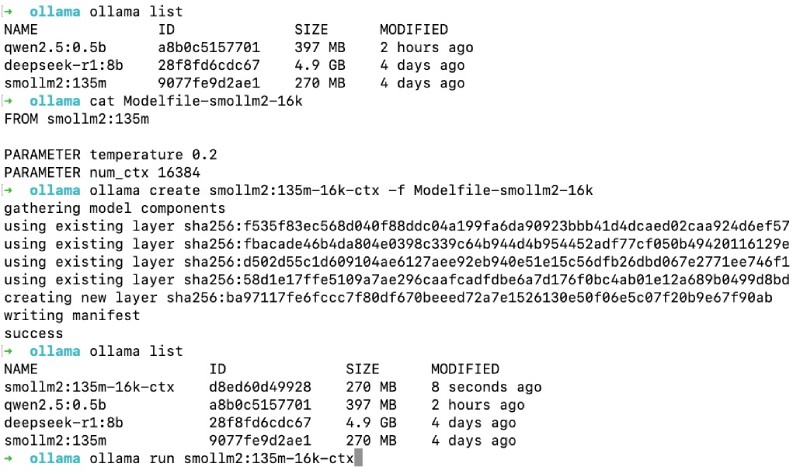
In the running model context, where you can type /? for help, if you type in /show info you will see the following output:
/show info
Model
architecture llama
parameters 134.52M
context length 8192
embedding length 576
quantization F16
Parameters
temperature 0.2
num_ctx 16384
stop "<|im_start|>"
stop "<|im_end|>"
System
You are a helpful AI assistant named SmolLM, trained by Hugging Face
License
Apache License
Version 2.0, January 2004This means the two parameters specified in the Model file, temperature and context window with num_ctx, are applied to the model. Because the temperature is set to a low value 0.2, if you ask this model variant, why is the sky blue? give me 1 sentence answer. even 3 times consecutively; it will give you almost the same answer as seen below:
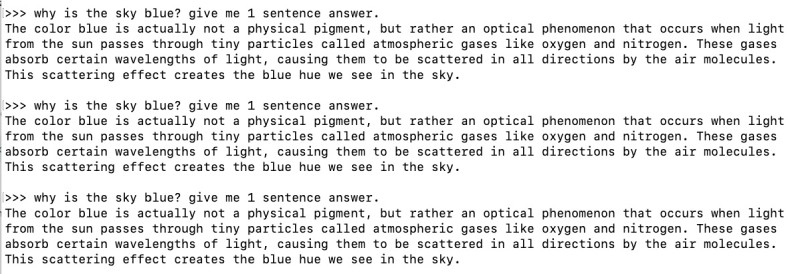
Next, you will learn about some other Ollama commands.
Other Ollama commands #
If you can pull a model, you can push a model to the Ollama registry. For this, you will need an Ollama account and API keys to share your model on Ollama.
Similarly, you can copy a model with ollama cp and remove a model with ollama rm followed by the model's name. You can also run ollama show <model-name> to see the configuration of the model; for example, ollama show smollm2:135m will show the following:
ollama show smollm2:135m
Model
architecture llama
parameters 134.52M
context length 8192
embedding length 576
quantization F16
Parameters
stop "<|im_start|>"
stop "<|im_end|>"
System
You are a helpful AI assistant named SmolLM, trained by Hugging Face
License
Apache License
Version 2.0, January 2004 The above output is the same as running /show info when the model runs within the CLI. As the new versions of Ollama are released, it may have new commands. To learn the list of Ollama commands, run ollama --help and find the available commands.
Ollama commands are similar to Docker commands, like pull, push, ps, rm. In the case of Docker, it works with Docker images or containers, and for Ollama, it works with open LLM models.
In the next part of this Ollama series, you will learn about the Ollama APIs. The CLI also uses these APIs; you will learn more about them so that another system can use them for LLM inference.
Conclusion #
In this comprehensive guide, you explored a wide range of essential Ollama commands, From ollama serve to ollama run, and from ollama pull to ollam create. By mastering these Ollama commands, you'll be well-equipped to harness the full potential of this powerful and easy-to-use framework, opening up a world of possibilities for your projects and applications. Whether you're a seasoned developer or just starting your journey into AI, Ollama and its commands will undoubtedly be invaluable assets in your toolkit. Keep learning!